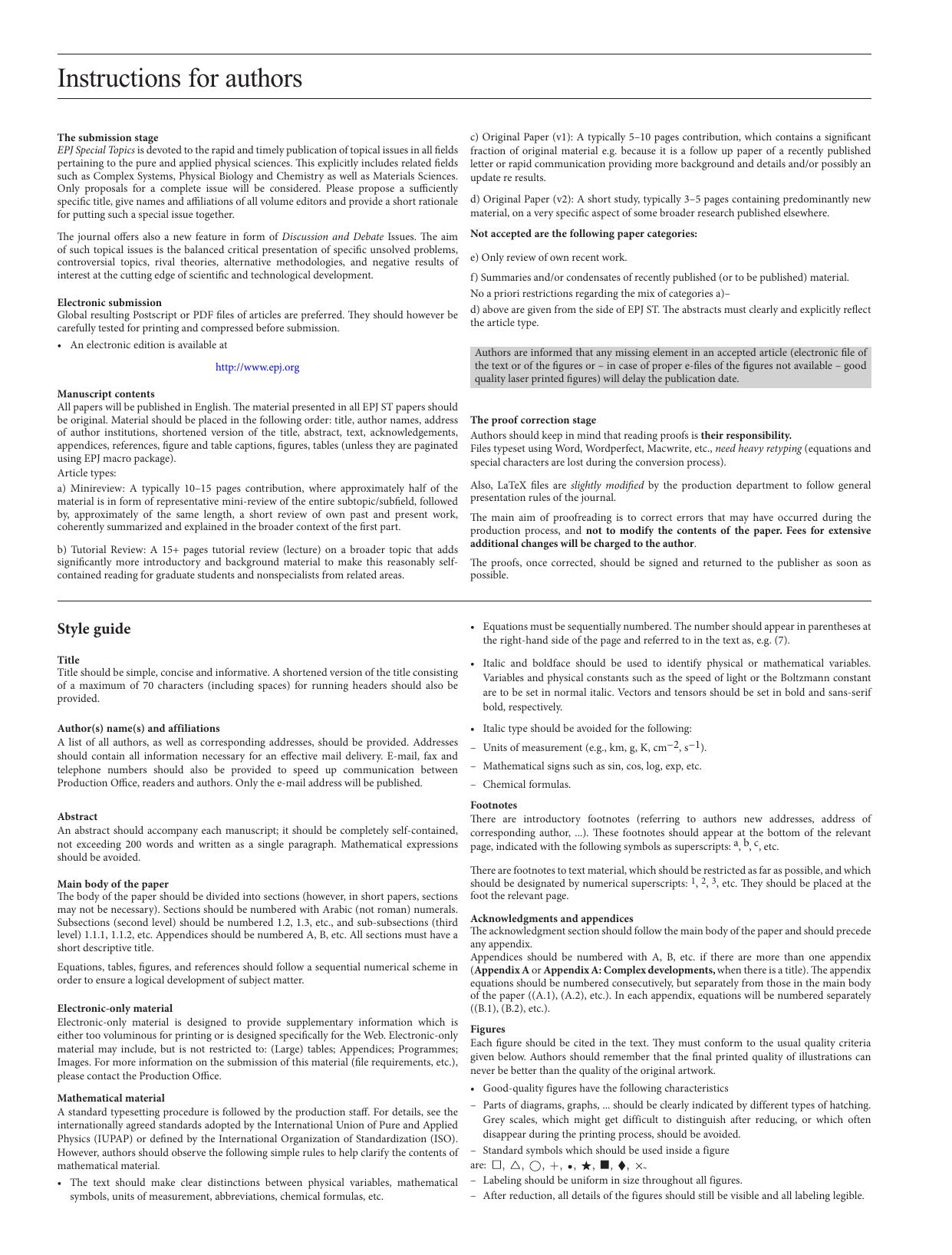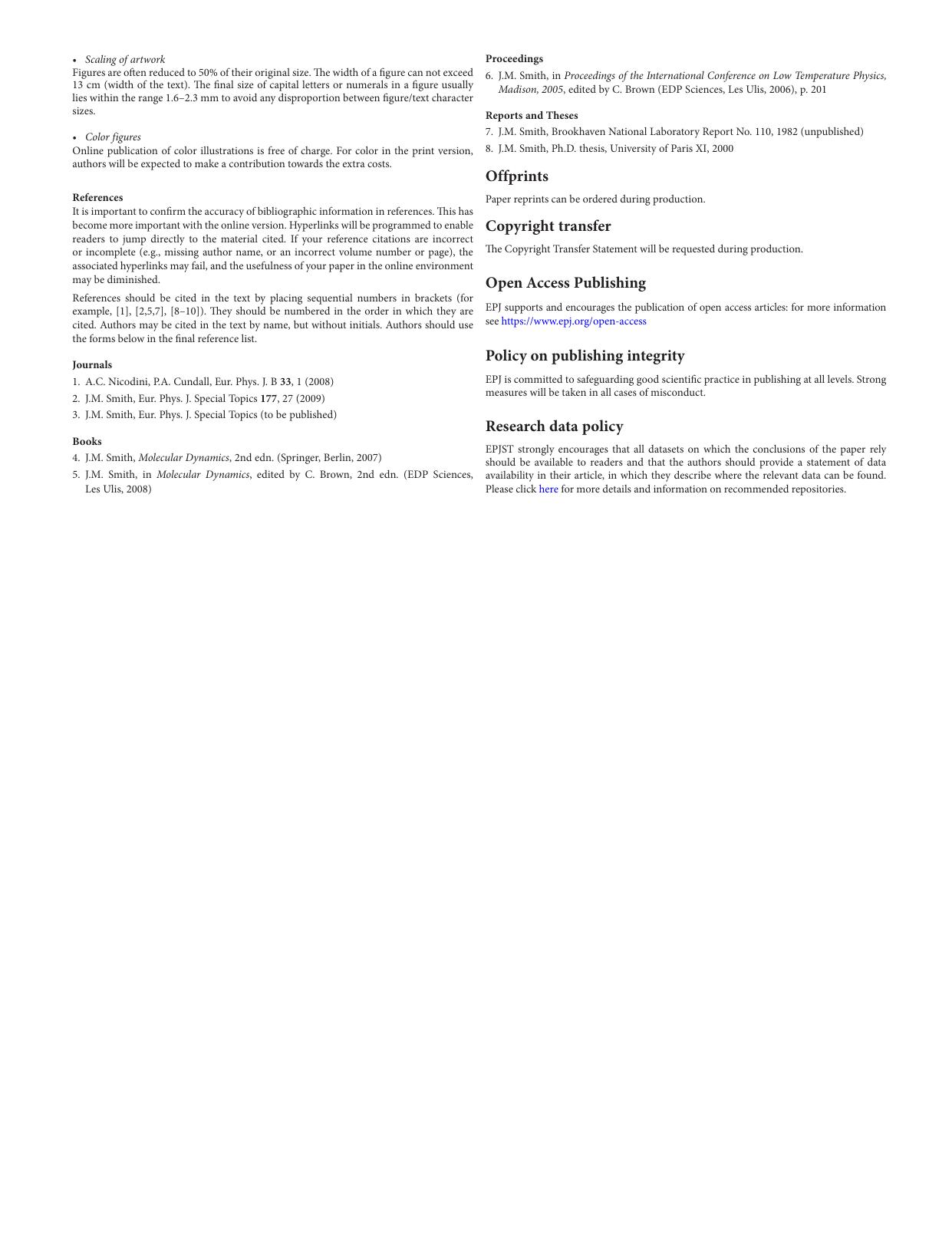科学网—EPJ ST Special Issue: Complex Bio Rhythms 无出版费的专题稿件 - 马军的博文.pdf
Instructions for authors The submission stage EPJ Special Topics is devoted to the rapid and timely publication of topical issues in all fields pertaining to the pure and applied physical sciences. This explicitly includes related fields such as Complex Systems, Physical Biology and Chemistry as well as Materials Sciences. Only proposals for a complete issue will be considered. Please propose a sufficiently specific title, give names and affiliations of all volume editors and provide a short rationale for putting such a special issue together. c) Original Paper (v1): A typically 5–10 pages contribution, which contains a significant fraction of original material e.g. because it is a follow up paper of a recently published letter or rapid communication providing more background and details and/or possibly an update re results. The journal offers also a new feature in form of Discussion and Debate Issues. The aim of such topical issues is the balanced critical presentation of specific unsolved problems, controversial topics, rival theories, alternative methodologies, and negative results of interest at the cutting edge of scientific and technological development. Not accepted are the following paper categories: Electronic submission Global resulting Postscript or PDF files of articles are preferred. They should however be carefully tested for printing and compressed before submission. • An electronic edition is available at http://www.epj.org Manuscript contents All papers will be published in English. The material presented in all EPJ ST papers should be original. Material should be placed in the following order: title, author names, address of author institutions, shortened version of the title, abstract, text, acknowledgements, appendices, references, figure and table captions, figures, tables (unless they are paginated using EPJ macro package). Article types: a) Minireview: A typically 10–15 pages contribution, where approximately half of the material is in form of representative mini-review of the entire subtopic/subfield, followed by, approximately of the same length, a short review of own past and present work, coherently summarized and explained in the broader context of the first part. b) Tutorial Review: A 15+ pages tutorial review (lecture) on a broader topic that adds significantly more introductory and background material to make this reasonably selfcontained reading for graduate students and nonspecialists from related areas. d) Original Paper (v2): A short study, typically 3–5 pages containing predominantly new material, on a very specific aspect of some broader research published elsewhere. e) Only review of own recent work. f) Summaries and/or condensates of recently published (or to be published) material. No a priori restrictions regarding the mix of categories a)– d) above are given from the side of EPJ ST. The abstracts must clearly and explicitly reflect the article type. Authors are informed that any missing element in an accepted article (electronic file of the text or of the figures or – in case of proper e-files of the figures not available – good quality laser printed figures) will delay the publication date. The proof correction stage Authors should keep in mind that reading proofs is their responsibility. Files typeset using Word, Wordperfect, Macwrite, etc., need heavy retyping (equations and special characters are lost during the conversion process). Also, LaTeX files are slightly modified by the production department to follow general presentation rules of the journal. The main aim of proofreading is to correct errors that may have occurred during the production process, and not to modify the contents of the paper. Fees for extensive additional changes will be charged to the author. The proofs, once corrected, should be signed and returned to the publisher as soon as possible. Style guide • Equations must be sequentially numbered. The number should appear in parentheses at the right-hand side of the page and referred to in the text as, e.g. (7). Title Title should be simple, concise and informative. A shortened version of the title consisting of a maximum of 70 characters (including spaces) for running headers should also be provided. • Italic and boldface should be used to identify physical or mathematical variables. Variables and physical constants such as the speed of light or the Boltzmann constant are to be set in normal italic. Vectors and tensors should be set in bold and sans-serif bold, respectively. Author(s) name(s) and affiliations A list of all authors, as well as corresponding addresses, should be provided. Addresses should contain all information necessary for an effective mail delivery. E-mail, fax and telephone numbers should also be provided to speed up communication between Production Office, readers and authors. Only the e-mail address will be published. • Italic type should be avoided for the following: –– Units of measurement (e.g., km, g, K, cm−2, s−1). Abstract An abstract should accompany each manuscript; it should be completely self-contained, not exceeding 200 words and written as a single paragraph. Mathematical expressions should be avoided. Main body of the paper The body of the paper should be divided into sections (however, in short papers, sections may not be necessary). Sections should be numbered with Arabic (not roman) numerals. Subsections (second level) should be numbered 1.2, 1.3, etc., and sub-subsections (third level) 1.1.1, 1.1.2, etc. Appendices should be numbered A, B, etc. All sections must have a short descriptive title. Equations, tables, figures, and references should follow a sequential numerical scheme in order to ensure a logical development of subject matter. Electronic-only material Electronic-only material is designed to provide supplementary information which is either too voluminous for printing or is designed specifically for the Web. Electronic-only material may include, but is not restricted to: (Large) tables; Appendices; Programmes; Images. For more information on the submission of this material (file requirements, etc.), please contact the Production Office. Mathematical material A standard typesetting procedure is followed by the production staff. For details, see the internationally agreed standards adopted by the International Union of Pure and Applied Physics (IUPAP) or defined by the International Organization of Standardization (ISO). However, authors should observe the following simple rules to help clarify the contents of mathematical material. • The text should make clear distinctions between physical variables, mathematical symbols, units of measurement, abbreviations, chemical formulas, etc. –– Mathematical signs such as sin, cos, log, exp, etc. –– Chemical formulas. Footnotes There are introductory footnotes (referring to authors new addresses, address of corresponding author, ...). These footnotes should appear at the bottom of the relevant page, indicated with the following symbols as superscripts: a, b, c, etc. There are footnotes to text material, which should be restricted as far as possible, and which should be designated by numerical superscripts: 1, 2, 3, etc. They should be placed at the foot the relevant page. Acknowledgments and appendices The acknowledgment section should follow the main body of the paper and should precede any appendix. Appendices should be numbered with A, B, etc. if there are more than one appendix (Appendix A or Appendix A: Complex developments, when there is a title). The appendix equations should be numbered consecutively, but separately from those in the main body of the paper ((A.1), (A.2), etc.). In each appendix, equations will be numbered separately ((B.1), (B.2), etc.). Figures Each figure should be cited in the text. They must conform to the usual quality criteria given below. Authors should remember that the final printed quality of illustrations can never be better than the quality of the original artwork. • Good-quality figures have the following characteristics –– Parts of diagrams, graphs, ... should be clearly indicated by different types of hatching. Grey scales, which might get difficult to distinguish after reducing, or which often disappear during the printing process, should be avoided. –– Standard symbols which should be used inside a figure are:. –– Labeling should be uniform in size throughout all figures. –– After reduction, all details of the figures should still be visible and all labeling legible. • Scaling of artwork Figures are often reduced to 50% of their original size. The width of a figure can not exceed 13 cm (width of the text). The final size of capital letters or numerals in a figure usually lies within the range 1.6–2.3 mm to avoid any disproportion between figure/text character sizes. • Color figures Online publication of color illustrations is free of charge. For color in the print version, authors will be expected to make a contribution towards the extra costs. References It is important to confirm the accuracy of bibliographic information in references. This has become more important with the online version. Hyperlinks will be programmed to enable readers to jump directly to the material cited. If your reference citations are incorrect or incomplete (e.g., missing author name, or an incorrect volume number or page), the associated hyperlinks may fail, and the usefulness of your paper in the online environment may be diminished. References should be cited in the text by placing sequential numbers in brackets (for example, [1], [2,5,7], [8–10]). They should be numbered in the order in which they are cited. Authors may be cited in the text by name, but without initials. Authors should use the forms below in the final reference list. Journals 1. A.C. Nicodini, P.A. Cundall, Eur. Phys. J. B 33, 1 (2008) 2. J.M. Smith, Eur. Phys. J. Special Topics 177, 27 (2009) 3. J.M. Smith, Eur. Phys. J. Special Topics (to be published) Books 4. J.M. Smith, Molecular Dynamics, 2nd edn. (Springer, Berlin, 2007) 5. J.M. Smith, in Molecular Dynamics, edited by C. Brown, 2nd edn. (EDP Sciences, Les Ulis, 2008) Proceedings 6. J.M. Smith, in Proceedings of the International Conference on Low Temperature Physics, Madison, 2005, edited by C. Brown (EDP Sciences, Les Ulis, 2006), p. 201 Reports and Theses 7. J.M. Smith, Brookhaven National Laboratory Report No. 110, 1982 (unpublished) 8. J.M. Smith, Ph.D. thesis, University of Paris XI, 2000 Offprints Paper reprints can be ordered during production. Copyright transfer The Copyright Transfer Statement will be requested during production. Open Access Publishing EPJ supports and encourages the publication of open access articles: for more information see https://www.epj.org/open-access Policy on publishing integrity EPJ is committed to safeguarding good scientific practice in publishing at all levels. Strong measures will be taken in all cases of misconduct. Research data policy EPJST strongly encourages that all datasets on which the conclusions of the paper rely should be available to readers and that the authors should provide a statement of data availability in their article, in which they describe where the relevant data can be found. Please click here for more details and information on recommended repositories.

 科学网—EPJ ST Special Issue: Complex Bio Rhythms 无出版费的专题稿件 - 马军的博文.pdf
科学网—EPJ ST Special Issue: Complex Bio Rhythms 无出版费的专题稿件 - 马军的博文.pdf 
